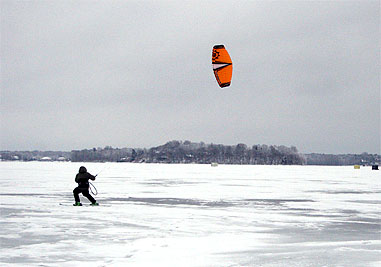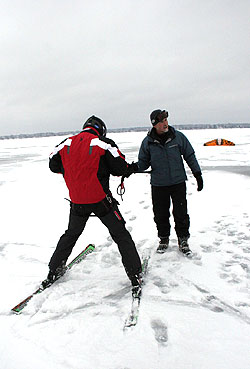A great nylon sheet is flapping on the ice, stirring in the wind and threatening to rise. I am standing in skis on a frozen lake, my hands fumbling with parachute lines strewn ahead on the snow. “Get that bar spun over,” shouts Tighe Belden, my instructor for the day. “Here it goes!”
The kite rockets skyward, a tremendous whoophff! of force as nylon billows and bursts to a half-moon shape 100 feet in the air. Lines stretch and come taut, yanking my tethered body away from Belden, alone for a ride eastbound across the ice.

Snowkiting on White Bear lake, Minn.
It is hour three of a half-day clinic with Lakawa School of Kiteboarding, Belden’s Minneapolis company. Six students have signed up to learn to kite — skis, snowboards and intermittent gusts enabling a strange locomotion across a bright expanse of White Bear Lake north of the Twin Cities.
The sport of snowkiting entered the extreme-sports lexicon more than a decade ago. Its roots stretch back 30 years, when pioneers stepped into skis and lofted parachutes in barren fields and frozen bays from Switzerland to Lake Erie.
But today the sport is almost mainstream. Equipment improvements, certification programs for instructors, and dozens of festivals and clinics each winter around the country make snowkiting accessible to a demographic far beyond the adrenaline fringe.
“Most students require only one day to learn the basics,” Belden said.
Grasping the dynamics of a giant kite aloft 100 feet in wind is step No. 1 to understanding the sport. And so Lakawa lessons begin with a classroom tutorial on safety and kite control. My group met in a coffee shop where Belden gave a lesson with diagrams and miniature kites to use as props. “This is the zenith position,” he said, holding a model wing above his head.
On the lake, we would start with small foil kites, which are fabric canopies with stitched cells made to inflate when flying. A harness hooks you to lines tethered to the half-moon wing, which surges skyward in a gust.

Instructor Tighe Belden on the ice with a student
A powerful wind, Belden said, can pick up a 200-pound man and drag him down the lake. “But that’s what this one is for,” he said, fingering an emergency quick-release strap on the harness.
Outside, for the first hour of the lesson, Belden instructed on the intricacies of flight with trainer kites. After unpacking a 6-foot-wide canopy, Belden walked toward the group trailing line from a control bar.









